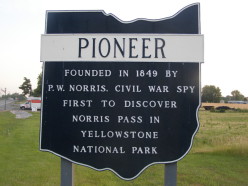Earliest recorded settlers of Pioneer were P.W. Norris and Owen McCarty (brothers-in-law), who were hired to clear James A. Rogers land in 1842-3. That land was section 17 of Williams County. Pioneer is located today in 16, 17, 20 and 21.
In 1844 Silander Johnson and Family arrived and James Rogers and family soon after P.W. Norris traveled to Fayette to claim Jane Cottrill as his bride - slashing a trail to bring her to Pioneer. In 1848, G.R. Joy moved to Pioneer from Morenci, Michigan after buying 160 acres on the west edge of the small village. He had built the first house in Morenci and remarked that there were only four houses between Pioneer and Bryan. In January of 1849, Samuel Doolittle built a house in section 21. He was followed in the spring of 1850 by his father, Ebenizer Doolittle and Benson Doolittle (Brother).
The 1850 census counted 222 people living in the village of Pioneer. Many of those families are still represented. The first child born in Pioneer was either Mirelia Norris b. 1844 or Jacob Dohm. There is no record available to verify who holds that honor. Some of the local names from the 1850 census still represented in the area are Snow, Dohm, Drake, Coulon, Stiving, Rogers, Doriot, Poorman, Johnson, Bailey, Sweetman, Loomis, Young, Evers, Fenicle, Shaffer, Yoder, Durbin, Shankster, Orewiler, Dick, Fisher, Sheets (Sheats), Norris and McCarty. Other pre-1860 families included Dr. Richard Gaudern, Olin Kenyon, Warren Fulton, Jasper Best, C. VanOrsdale, Andy Irvin, Cummins and Cainfield.
Early business was spurred by the real rivalry between P.W. Norris and G.R. Joy, who were married to the Cottrell sisters. Each actively sought to make his parto f town more prosperous. P.W. managed to b e named postmaster in 1850, but could not name the town after himself, so he named it Pioneer. Pioneer was laid out into streets in 1853.
P.W. got Andy Irwin to build the Pioneer Hotel on the north side in 1854. Not to be outdone, G.R. Joy erected the Joy Hotel on the south side of the creek the following year. That building still stands next to the Laundromat mid-block of second block of First street.










